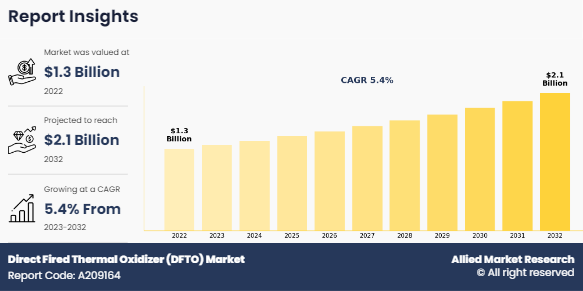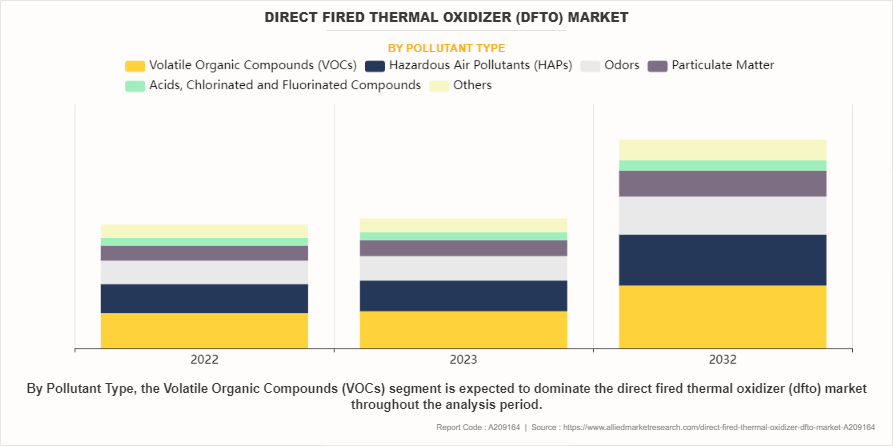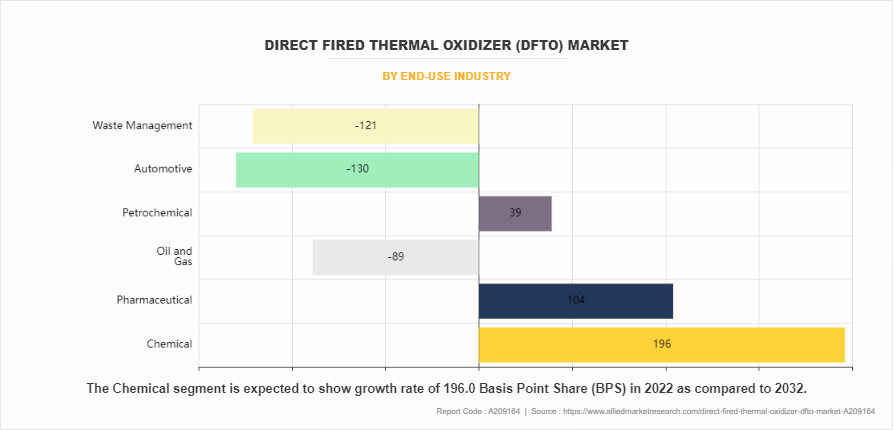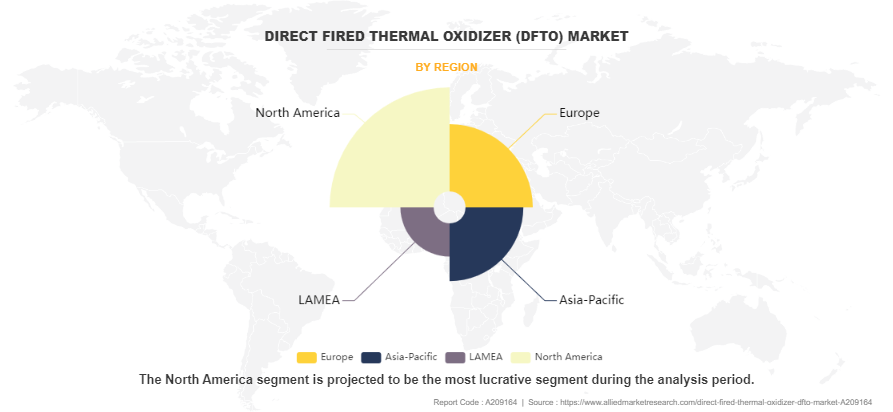Direct Fired Thermal Oxidizer (DFTO) Market Research, 2032
The global direct fired thermal oxidizer (DFTO) market size was valued at $1.3 billion in 2022, and is projected to reach $2.1 billion by 2032, growing at a CAGR of 5.4% from 2023 to 2032. Direct fired thermal oxidizers (DFTOs) are robust air pollution control systems designed to thermally destroy hazardous air pollutants (HAPs) and volatile organic compounds (VOCs) emitted from industrial processes.

Direct fired thermal oxidizer is also known as afterburners or enclosed flares, DFTOs operate by subjecting contaminated air to high temperatures within a combustion chamber, where pollutants undergo oxidation and transform into harmless byproducts such as water vapor and carbon dioxide. Manufacturers facing challenges with high concentrations of VOCs and HAPs in their emissions often struggle to find suitable thermal oxidation systems that meet regulatory compliance standards. Traditional oxidation solutions may fail or be damaged when exposed to such high concentrations over extended periods. In such cases, direct fired thermal oxidizer (DFTO) industry, emerge as a reliable solution, capable of efficiently handling high-VOC emissions and ensuring compliance with environmental regulations.
Key Takeaways of Direct Fired Thermal Oxidizer (DFTO) Market Report
- Based on pollutant type, the volatile organic compounds (VOCs) sub-segment emerged as the global leader in 2022 and it is anticipated to be the fastest growing during the forecast period.
- Based on end-use industry, the chemical sub-segment emerged as the global leader in 2022 and it is predicted to show the fastest growth in the upcoming years.
- Based on region, North America registered the highest market share in 2022 and the Asia-Pacific is projected to show the fastest growth during the forecast period.
Segment Overview
The direct fired thermal oxidizer (DFTO) market overview is segmented into Pollutant Type and End-use Industry.

By pollutant type, the volatile organic compounds (VOCs) sub-segment dominated the global direct fired thermal oxidizer (DFTO) market share in 2022. Direct fired thermal oxidizers (DFTOs) are utilized for eliminating volatile organic compounds (VOCs) due to their efficiency and reliability in high-temperature oxidation processes. VOCs are a diverse group of carbon-based chemicals that easily vaporize at room temperature and can pose significant environmental and health risks. They contribute to air pollution, smog formation, and can have adverse effects on human health, including respiratory issues and potential carcinogenicity.
DFTOs play a crucial role in eliminating VOCs by subjecting VOC-laden air streams to elevated temperatures within a combustion chamber, typically ranging from 760°C to 980°C (1400°F to 1800°F). This thermal oxidation process breaks down the VOC molecules into simpler, less harmful compounds such as carbon dioxide and water vapor, rendering them inert and non-toxic. It is important to eliminate VOCs using DFTOs to mitigate the adverse environmental and health effects associated with their emissions. By implementing DFTOs, industries can effectively control VOC emissions, ensuring compliance with environmental regulations and promoting cleaner air quality.

By end-use industry, the chemical sub-segment dominated the global direct fired thermal oxidizer (DFTO) market analysis in 2022. Direct Fired Thermal Oxidizers (DFTOs) are widely used in the chemical industry for their effectiveness in controlling emissions of volatile organic compounds (VOCs) and hazardous air pollutants (HAPs). Chemical manufacturing processes often involve the use of solvents, catalysts, and other organic compounds that can emit VOCs into the atmosphere. DFTOs provide a reliable and efficient solution for mitigating these emissions, ensuring compliance with stringent environmental regulations, and promoting sustainable industrial practices.
Leading chemical manufacturers such as Dow Chemical Company, BASF SE, and DuPont are among those that utilize DFTOs in their operations. These companies prioritize environmental awareness and have recognized the importance of controlling VOC emissions to minimize their environmental impact. By implementing DFTOs, chemical manufacturers can effectively reduce VOC emissions, mitigate air pollution, and protect the health and well-being of surrounding communities. These factors are anticipated to have a positive impact on the chemical sub-segment of the direct fired thermal oxidizer (DFTO) market during the forecast years.

By region, North America dominated the global direct fired thermal oxidizer (DFTO) market in 2022. North America leads the world in the use of direct fired thermal oxidizers (DFTOs) due to several factors. Firstly, the region has stringent environmental regulations enforced by agencies like the Environmental Protection Agency (EPA), which require industries to control emissions of volatile organic compounds (VOCs) and hazardous air pollutants (HAPs). Consequently, industries in North America, such as chemical manufacturing, automotive, aerospace, and pharmaceuticals, heavily rely on DFTOs to meet these regulatory requirements.
Leading companies in North America that utilize DFTOs include ExxonMobil, Chevron Phillips Chemical Company, and 3M Company. DFTO systems offer efficient and reliable VOC abatement solutions, ensuring compliance with environmental regulations while optimizing operational efficiency. As industries continue to prioritize emission control and sustainability, the demand for DFTOs in North America is expected to remain prominent in the coming years.
Competitive Analysis
The key players profiled in this report include Epcon Industrial Systems, LP, Anguil Environmental Systems, Inc., TANN Corporation, Ship & Shore Environmental, Inc., NestecInc.com, Catalytic Products International, Process Combustion Corporation (PCC), Dürr Systems, Inc., The CMM Group, and AIR CLEAR LLC. In a recent interview held in October 2023, with AZoCleantech, the leading online publication for the Clean Technology community, Anguil, the leading manufacturer of thermal oxidizers, highlighted the pollution control challenges faced by battery manufacturing and the journey towards greener practices from mining to recycling. The battery production chain, from mining to recycling, necessitates air pollution control and wastewater treatment due to volatile organic compounds (VOCs) and hazardous air pollutants (HAPs) generated throughout the process. With a focus on maintaining environmental stewardship, the industry aims to address climate challenges by producing energy storage solutions responsibly.
Market Dynamics
Direct fired thermal oxidizers (DFTOs) play a crucial role in industrial air pollution control as DFTOs boast unparalleled destruction efficiencies, exceeding 99%. This exceptional capability makes them highly effective in eliminating volatile organic compounds (VOCs) and hazardous air pollutants (HAPs) from industrial emissions, ensuring compliance with stringent environmental regulations. Moreover, DFTOs exhibit remarkable versatility, capable of handling a wide range of waste streams, including those with high concentrations of pollutants. This versatility makes them suitable for diverse industrial applications across sectors such as plastics, chemicals, coatings, and more.
Cost-effectiveness further enhances the appeal of DFTOs, as they are among the least capital-intensive thermal oxidation systems available. Their efficient design and operation help minimize operating costs, making them a cost-effective solution for pollution control while optimizing operational efficiency. Flexibility is another key advantage of DFTOs, as they can utilize various fuel sources such as natural gas, propane, and biogas. This flexibility enables operators to select the most suitable fuel based on the specific requirements of their industrial processes, enhancing operational adaptability. These factors are anticipated to boost the direct fired thermal oxidizer (DFTO) market demand in the coming years.
While direct fired thermal oxidizers (DFTOs) offer several advantages, they also have some limitations that need to be considered. One significant limitation is their relatively high operating temperatures, typically ranging from 1,800 to 2,200 degrees Fahrenheit. These high temperatures may not be suitable for all types of waste streams, especially those containing heat-sensitive compounds or materials prone to thermal degradation. Additionally, DFTOs lack heat recovery systems, resulting in higher energy consumption compared to other thermal oxidizers.
In addition, compared to regenerative thermal oxidizers (RTOs), which are known for their high thermal efficiency and low fuel consumption, DFTOs generally have higher fuel requirements due to their direct combustion of pollutants. This can lead to higher operating costs over time, especially in applications with continuous emissions.
Furthermore, DFTOs may not be as effective in achieving ultra-low nitrogen oxide (NOx) emissions compared to selective catalytic reduction (SCR) systems or catalytic thermal oxidizers (CATOX). These alternative technologies offer more efficient NOx reduction mechanisms, which may be necessary to meet stringent emission regulations in certain industries or regions. These factors are anticipated to hamper the direct fired thermal oxidizer (DFTO) market forecast in the coming years.
Direct fired thermal oxidizers (DFTOs) present a compelling opportunity for industries such as oil & gas, chemical, food & beverage, and others, facing challenges in managing emissions related to volatile organic compounds (VOCs) and hazardous air pollutants (HAPs). One significant opportunity lies in the versatility and adaptability of DFTOs to diverse industrial settings. Whether it is the chemical industry, like Synthesia's carbodiimide production, or other sectors such as paint and coating, pharmaceuticals, or food processing, DFTOs can effectively handle emissions containing high concentrations of pollutants. This flexibility allows companies across different industries to adopt DFTOs as a viable option for pollution control, ensuring compliance with environmental regulations while optimizing operational efficiency.
Furthermore, the advancements in DFTO technology, including improved combustion control systems and enhanced heat recovery capabilities, enhance their appeal as a sustainable solution. By efficiently converting pollutants into harmless byproducts like water vapor and carbon dioxide, DFTOs contribute to reducing the environmental footprint of industrial operations. Additionally, their compact size and low maintenance requirements make them a cost-effective choice for businesses aiming to enhance energy efficiency and minimize operational costs. These factors are anticipated to have a positive impact on the direct fired thermal oxidizer (DFTO) market growth in the coming years.
Key Benefits for Stakeholders
- The report provides exclusive and comprehensive analysis of the global direct fired thermal oxidizer (DFTO) market trends along with the market forecast.
- The report elucidates the market opportunity along with key drivers, and restraints of the market. It is a compilation of detailed information, inputs from industry participants and industry experts across the value chain, and quantitative and qualitative assessment by industry analysts.
- Porter’s five forces analysis helps analyze the potential of the buyers & suppliers and the competitive scenario of the market for strategy building.
- The report entailing the market analysis maps the qualitative sway of various industry factors on market segments as well as geographies.
- The data in this report aims on market dynamics, trends, and developments affecting the market growth.
Direct Fired Thermal Oxidizer (DFTO) Market Report Highlights
| Aspects | Details |
| Market Size By 2032 | USD 2.1 billion |
| Growth Rate | CAGR of 5.4% |
| Forecast period | 2022 - 2032 |
| Report Pages | 310 |
| By Pollutant Type |
|
| By End-use Industry |
|
| By Region |
|
| Key Market Players | NestecInc.com, Ship & Shore Environmental, Inc., durr systems, inc., AIR CLEAR LLC, Epcon Industrial Systems, LP, Process Combustion Corporation (PCC), The CMM Group, Catalytic Products International, Anguil Environmental Systems, Inc., TANN Corporation |
The global direct fired thermal oxidizer (DFTO) market is driven by factors such as stringent environmental regulations, increasing industrialization, and growing awareness about air pollution control. Opportunities lie in the demand for cost-effective emission control solutions across various industries such as chemicals, automotive, petrochemicals, pharmaceuticals, and others.
The major growth strategies adopted by the direct fired thermal oxidizer (DFTO) market players are partnership, collaboration, business expansion, and product launch.
Asia-Pacific will provide more business opportunities for the global direct fired thermal oxidizer (DFTO) market in the future.
Epcon Industrial Systems, LP, Anguil Environmental Systems, Inc., TANN Corporation, Ship & Shore Environmental, Inc., NestecInc.com, Catalytic Products International, Process Combustion Corporation (PCC), Dürr Systems, Inc., The CMM Group, and AIR CLEAR LLC. are the major players in the direct fired thermal oxidizer (DFTO) market.
The volatile organic compounds (VOCs) sub-segment of the type segment acquired the maximum share of the global direct fired thermal oxidizer (DFTO) market in 2022.
The potential customers of the direct fired thermal oxidizer (DFTO) market include industries such as manufacturing, chemical processing, food production, pharmaceuticals, waste treatment, and automotive, and others.
Current trends in the DFTO market include increasing demand for sustainable pollution control solutions, advancements in energy efficiency, adoption of versatile fuel options, and integration of smart monitoring and control systems.
Loading Table Of Content...
Loading Research Methodology...



